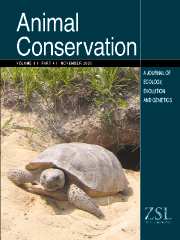Crossref Citations
This article has been cited by the following publications. This list is generated based on data provided by
Crossref.
Céréghino, Régis
Santoul, Frédéric
Compin, Arthur
and
Mastrorillo, Sylvain
2005.
Using self-organizing maps to investigate spatial patterns of non-native species.
Biological Conservation,
Vol. 125,
Issue. 4,
p.
459.
Gaston, Kevin J.
Jackson, Sarah F.
Nagy, Arnold
Cantú‐Salazar, Lisette
and
Johnson, Mark
2008.
Protected Areas in Europe.
Annals of the New York Academy of Sciences,
Vol. 1134,
Issue. 1,
p.
97.
de Castro Leão, Adriano
Duarte Dória Neto, Adrião
and
Bernardete Cordeiro de Sousa, Maria
2009.
New developmental stages for common marmosets (Callithrix jacchus) using mass and age variables obtained by K-means algorithm and self-organizing maps (SOM).
Computers in Biology and Medicine,
Vol. 39,
Issue. 10,
p.
853.
de Thoisy, Benoît
Richard-Hansen, Cécile
Goguillon, Bertrand
Joubert, Pierre
Obstancias, Jean
Winterton, Peter
and
Brosse, Sébastien
2010.
Rapid evaluation of threats to biodiversity: human footprint score and large vertebrate species responses in French Guiana.
Biodiversity and Conservation,
Vol. 19,
Issue. 6,
p.
1567.
Pleydell, David R.J.
and
Chrétien, Stéphane
2010.
Mixtures of GAMs for habitat suitability analysis with overdispersed presence/absence data.
Computational Statistics & Data Analysis,
Vol. 54,
Issue. 5,
p.
1405.
KOPP, DOROTHÉE
SANTOUL, FRÉDÉRIC
POULET, NICOLAS
COMPIN, ARTHUR
and
CÉRÉGHINO, RÉGIS
2010.
Patterning the distribution of threatened crayfish and their exotic analogues using self-organizing maps.
Environmental Conservation,
Vol. 37,
Issue. 2,
p.
147.
Eggermann, Julia
da Costa, Gonçalo Ferrão
Guerra, Ana M.
Kirchner, Wolfgang H.
and
Petrucci-Fonseca, Francisco
2011.
Presence of Iberian wolf (Canis lupus signatus) in relation to land cover, livestock and human influence in Portugal.
Mammalian Biology,
Vol. 76,
Issue. 2,
p.
217.
Simões, Romeu
Ferreira, Carla
Gonçalves, José
Álvares, Francisco
Rio-Maior, Helena
Roque, Sara
Brandão, Ricardo
and
Martins da Costa, Paulo
2012.
Occurrence of virulence genes in multidrug-resistant Escherichia coli isolates from Iberian wolves (Canis lupus signatus) in Portugal.
European Journal of Wildlife Research,
Vol. 58,
Issue. 4,
p.
677.
Fehérvári, P.
Solt, S.
Palatitz, P.
Barna, K.
Ágoston, A.
Gergely, J.
Nagy, A.
Nagy, K.
Harnos, A.
Altwegg, Res
and
Penteriani, Vincenzo
2012.
Allocating active conservation measures using species distribution models: a case study of red‐footed falcon breeding site management in the Carpathian Basin.
Animal Conservation,
Vol. 15,
Issue. 6,
p.
648.
Lobos, Gabriel
Cattan, Pedro
Estades, Cristian
and
Jaksic, Fabian M.
2013.
Invasive African clawed frogXenopus laevisin southern South America: key factors and predictions.
Studies on Neotropical Fauna and Environment,
Vol. 48,
Issue. 1,
p.
1.
Torres, Rita Tinoco
and
Fonseca, Carlos
2016.
Perspectives on the Iberian wolf in Portugal: population trends and conservation threats.
Biodiversity and Conservation,
Vol. 25,
Issue. 3,
p.
411.
Valavi, Roozbeh
Shafizadeh-Moghadam, Hossein
Matkan, AliAkbar
Shakiba, Alireza
Mirbagheri, Babak
and
Kia, Seyed Hossein
2019.
Modelling climate change effects on Zagros forests in Iran using individual and ensemble forecasting approaches.
Theoretical and Applied Climatology,
Vol. 137,
Issue. 1-2,
p.
1015.
Wang, Danyu
Shi, Chaoyi
Alamgir, Khan
Kwon, SeMyung
Pan, Leilei
Zhu, Yuanjun
and
Yang, Xiaohui
2022.
Global assessment of the distribution and conservation status of a key medicinal plant (Artemisia annua L.): The roles of climate and anthropogenic activities.
Science of The Total Environment,
Vol. 821,
Issue. ,
p.
153378.
Schoonemann, Jeanine
Nagelkerke, Jurriaan
Seuntjens, Terri G.
Osinga, Nynke
and
van Liere, Diederik
2024.
Applying XGBoost and SHAP to Open Source Data to Identify Key Drivers and Predict Likelihood of Wolf Pair Presence.
Environmental Management,
Vol. 73,
Issue. 5,
p.
1072.
Tu, Ya
Zhu, Yuanjun
Yang, Xiaohui
and
Eldridge, David J.
2024.
Predicted changes in distribution and grazing value of Stipa-based plant communities across the Eurasian steppe.
Journal of Environmental Management,
Vol. 356,
Issue. ,
p.
120757.


